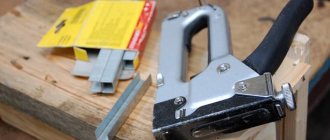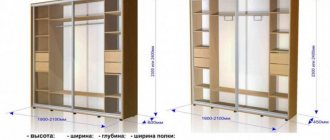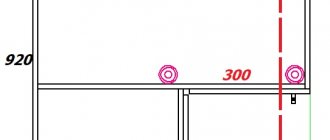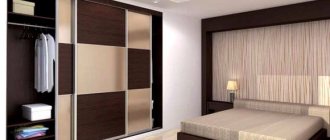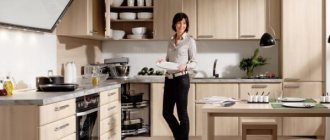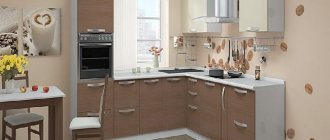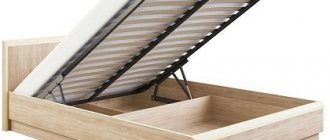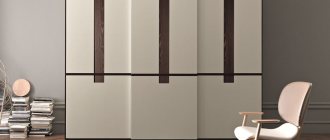A modern built-in refrigerator fits perfectly into the kitchen interior without disturbing the overall design concept. All models of built-in household appliances are designed for mounting facades made of the materials used in kitchen units. Overall dimensions allow the devices to be installed on the same level as kitchen furniture. Small models are installed under the countertop.
The interior space of standard and small refrigerators is equipped with many functional shelves, pull-out sections, containers for fruits/vegetables and meat products. On the doors, as in conventional refrigeration appliances: a place to store eggs, medicines, tall bottles, cans, sauces and other things. The freezer, as expected, is located above or below the main compartment.
Built-in refrigerator - what is it?
The built-in refrigerator is installed in the kitchen unit and looks like a single unit with it. Instead of standard doors, which can be seen on free-standing models, they have exactly the same facade as the entire set. Large models are inserted into a pencil case or cabinet, which is installed between two objects or one object and a wall, and is covered with false panels on the sides.
The doors of the integrated refrigerator are designed so that the doors of kitchen cabinets or bedside tables will be attached to them from the outside. This gives the refrigerator additional noise and sound insulation. Such a refrigerator is not visible in the kitchen design; the kitchen façade acquires trendy homogeneity and solidity.
What is the difference between built-in models and regular models?
The differences between built-in and conventional refrigerator models are the following:
- Devices intended for embedding are installed in a special cabinet having the appropriate dimensions. The refrigerator is not placed on the floor, but on the bottom of the furniture module. Freestanding models are installed in cabinets that do not have a bottom.
- Furniture fronts are attached with special clamps to the refrigerator door. It is impossible to do this when building in a free-standing device.
Pros and cons of building in a refrigerator
When you make a furniture module with your own hands, you get a design that fits well into the interior of the kitchen. The choice of configuration depends on the parameters of the refrigerator. The installation location and design are selected taking into account the user's wishes. Disadvantages of embedding include:
- Insufficient ventilation. If built-in models have a specially organized ventilation system, a regular refrigerator does not have such an element. Insufficient ventilation causes the compressor and evaporator to overheat. Creating holes in the back of the cabinet does not help with this problem.
- Instability of the structure. To ensure air flow, the design of the pencil case does not include a back wall. If you attach the furniture module to the wall, ventilation will deteriorate.
- Reducing the usable area of the room. It is not possible to install cabinets in which free-standing refrigerators are built into small kitchens. This causes inconvenience when operating the device.
When to choose a built-in refrigerator
It is recommended to buy a built-in refrigerator for those who cannot decide on the design of the refrigerator and strive to create a kitchen in a single design. Those who absolutely do not like white cabinets and those who want the refrigerator to be completely invisible.
A built-in refrigerator is not recommended for those who cook a lot and who need large models. For those who value functionality, the presence of electronic controls on the outside of the door, a freshness zone inside and the ability to make soda. And also for those who want to save money and not overpay for expensive thermal insulation.
Built-in refrigerator - advantages and disadvantages
First of all, integrated refrigerators have a higher price: no less than 20% compared to their free-standing brothers. This is explained by the fact that due to the lack of an external casing, manufacturers are forced to use expensive thermal insulation with minimal thermal conductivity.
In addition, manufacturers use the highest quality materials in them, because if such a refrigerator breaks down, the cost of delivering it to a service center increases due to the need to dismantle the device.
Secondly, the choice of built-in refrigerators is small. According to online stores, out of more than 3,000 models offered, only a little over 500 are built-in. Competition between manufacturers is low, and there is little incentive to create inexpensive models.
Also, built-in refrigerators almost always have a smaller internal volume than their free-standing counterparts. In addition, built-in equipment cannot be moved to another location. And in case of repair, the device will have to be dismantled and taken to a service center. During the renovation, the kitchen will look like there is a “hole” in the middle of the unit.
Among the advantages include high energy efficiency. Built-in models, due to expensive thermal insulation, consume 20% less electricity. They are more reliable due to the use of higher quality parts.
Built-in refrigerators are completely silent. External finishing panels create additional sound insulation.
But the main advantage is their complete invisibility. There is no need to select equipment based on style, color and design. In the context of design, they do not create disadvantages in the kitchen.
Hallway design with appliances
When you plan to install a refrigerator in the hallway, many questions arise. For example, you need to transform the device to match the design of the hallway or vice versa. But professional designers in this case give some advice.
- It is better to adapt the refrigerator to the design of the hallway.
- First of all, it is worth considering the option with built-in equipment. This will significantly save space, and if there are light colors, the space will visually appear even larger.
- For those who place the refrigerator outside the cabinet, it is recommended to build a “window” between the hallway and the kitchen for ease of moving food.
- The unit must be placed so that it does not interfere with normal activities and does not impede access to frequently used things.
- If the hallway is made in a classic style, it is better to use standard models of refrigerators; you can paste them over wood or to match the colors of the corridor.
- For a high-tech style hallway, a refrigerator with a metallic gray touch panel is best suited, and the presence of additional equipment in such a hallway will only be appropriate.
- The height and color of the unit should not stand out from the general style of the interior.
How to choose a built-in refrigerator
Built-in refrigerators differ in size, number of chambers and location of the freezer compartment, internal volume and other functional characteristics. Sometimes choosing the right model can be difficult.
Built-in refrigerator - dimensions
The dimensions of built-in refrigerators are standard for all manufacturers of both refrigeration cabinets themselves and kitchen units and easily fit into the dimensions of cabinets and cabinets under countertops.
The height of the built-in refrigerator in large models is 177-200 cm, small models built under the countertop are up to 82 cm. Medium modifications with a height of 90-110 cm are available for sale. They are designed for installation in one cabinet with an oven and microwave or are additionally equipped with several freezers. Find out prices for built-in refrigerators.
The width of the devices is 54-56 cm with the expectation of installation in a standard 60 cm cabinet. This is true for both small and large refrigerators.
There are no wide devices or they are supplied to order.
The depth of refrigerated cabinets is standard and is no more than 55 cm.
It is recommended to choose the refrigerator capacity depending on the number of family members. For one person 120-150 liters are enough, for 2-3 people 120-200 liters are needed, for 4 or 5 people 200-300 liters are needed. If the family consists of 6 or more people, then the refrigerator should be the largest with an internal volume of 300 liters or more.
Built-in refrigerator - functions and design
Small models of buildable refrigerators have only one chamber. Medium and tall built-in refrigerators are equipped with 2-3 chambers, 1 or 2 of which are freezer compartments. There are freezers with only one freezer compartment.
Double-chamber refrigerators can have a top or bottom freezer compartment. There are devices in which the freezer compartment is located on the left. The volume of a standard freezer is 60-70 liters.
A large number of integrated refrigerators are equipped with inverter compressors. Unlike standard ones, which operate in on/off mode, inverter ones operate constantly and provide uniform air temperature.
Some two-chamber refrigerators can be equipped with two compressors. This allows you to set the operating mode of each compressor independently or turn off one chamber to save energy.
Refrigerators can have either manual or automatic defrosting. Automatic defrosting is represented by the No Frost system, which does not form frost, or the drip defrosting system.
Built-in refrigerator - defrosting system
When choosing a refrigerator, you should also pay attention to the defrosting system it uses. In total, there are 3 types of defrosting refrigerators - drip, air (aka No Frost) and combined. The first type of defrosting is that there is a special hole on the back wall inside the refrigerator into which water formed as a result of condensation resulting from temperature changes when the refrigerator door is opened. This system is most often used in single-chamber refrigerators. The advantage of this type of defrosting is that ice will not freeze in the refrigerator compartment, but it can form in the freezer, which is a disadvantage of this system. The air system will protect against the appearance of ice in both the refrigerator and freezer compartments. With this defrosting system, you will only need to force defrost the refrigerator once a year just to clean it. The disadvantage of this system is that opened products will dry out, and to prevent this from happening they will have to be hermetically packaged. The combination system is an ideal defrosting system option, which is used in more expensive models. Its essence lies in the fact that the refrigeration compartment uses a drip system, and the freezer uses an air system, thus preventing the drying of open products and the appearance of ice.
Built-in refrigerator - energy class
The refrigerator is one of the most energy-hungry household devices. Manufacturers of modern refrigerators are trying to reduce the energy consumption of these household appliances. In total, there are 9 energy consumption classes, which are marked in Latin letters (from A to G). The most energy efficient are A++ and A+, while G is the most energy consuming class. A refrigerator with a class A, B, A+ or A++ will be acceptable; in the case of other options, you will have to fork out for electricity.
Integration into a conventional refrigerator set
A free-standing large refrigerator can also be built into a closet or pencil case. This can increase the attractiveness of the interior and create a unified style in the kitchen, but this requires additional space, since the cabinet will take up a lot of space.
There are two possible ways to install a conventional refrigerator:
- creating a pencil case;
- imitation of embedding with decorative means.
Both options can be done independently.
Preparatory stage - dimensions, materials, tools
You can make a cabinet from MDF or chipboard. It is also possible to use drywall, but the niche made from it will be heavy; this material requires special working skills. MDF is more beautiful, but more expensive, so if you have little experience, it is better to choose laminated chipboard - it is cheaper, the cost of a mistake will not be so high. It is better to choose slabs with a thickness of 16 mm.
You will need a 2mm thick melamine edge. Its shade must match the base material.
You will also need:
- furniture hinges - 5-7 pieces;
- two furniture handles;
- self-tapping screws, bolts and nuts;
- metal corners - 4 pieces;
- confirmations;
- minifixes;
- level and ruler;
- pencil;
- drill with drills;
- jigsaw;
- ball-type guides - 2 pieces.
It is important to take the measurements correctly. The cabinet under the refrigerator should have space for air circulation so that the furniture and appliance do not overheat. Overheating is dangerous not only due to increased energy consumption, but also due to fire.
The optimal dimensions of the pencil case for a standard refrigerator width of 600 mm, such as, for example, the familiar Atlant household model:
| External cabinet width | Must have a margin of 28 mm for loops. Considering the thickness of the material, with a refrigerator width of 600 mm, the cabinet width is about 660 mm (28+16+16+600). |
| Height | This is at the discretion of the craftsman, the main thing is to take into account the ventilation gap at the top (at least 50 mm after the height of the refrigerator). You can make a cabinet flush with the set, for example, 216 mm high. |
| Depth | A minimum of 50mm must be added to the depth of the refrigerator for ventilation. The standard option is 650 mm. |
| Shelf or cabinet lid on top | The length is taken equal to the width of the cabinet minus the thickness of the sides (660-16-16=628), and it is better to take the width 100 mm less to form a ventilation hole. You can make the lid/shelf blank, but then you will have to provide ventilation in the back wall of the cabinet. |
| Rear strut | The width is taken equal to the internal width of the cabinet; it is better to choose a height of 150-160 mm, which will ensure the best ventilation. If you make the back wall blank, you will have to drill holes in it. Sometimes they do without a back wall at all, but then the cabinet becomes less stable. |
| Two bottom struts | The height is taken to be 50 mm, the width is equal to the internal width of the cabinet. |
| Base | The length is equal to the width of the cabinet, the height is slightly less than the distance from the floor to the door. For example, if this gap is 80 mm, the base is taken to be 68 mm. |
| Facades | The width of the facades is calculated taking into account 2 mm edges on both sides, and the length is calculated taking into account the 5 mm gap between the doors, required in case of subsidence. |
Having decided on the dimensions, you can send the diagram and materials for cutting, edging, or cut out the parts yourself.
TIP: when cutting with your own hands, it is better to use a jigsaw - it provides the smoothest edges.
Pencil case assembly stage
The installation of the box is similar to the assembly of the construction set.
The side parts and the top panel are connected with minifixes. The back wall is attached to the sides with corners. If the cabinet included a shelf above the refrigerator, it is secured with confirmations. If spacers are used instead of a solid back wall, they are also attached with corners: the upper one (10-15 cm high) is in the middle of the height of the cabinet, the lower one (5 cm) is at the bottom of the frame.
Now the cabinet is placed in its intended place. It is leveled and secured with corners to other cabinets and drawers of the kitchen unit and to the wall for stability.
Next, the front lower strut is mounted, it is attached behind the plinth. Corners are used again, one side of which is connected to the side of the frame, the other to the floor.
The last stage of creating a pencil case is the installation of facade hinges to one of the side parts. For the freezer, two hinges are enough, for the main chamber of the refrigerator - four.
Stage of installing a refrigerator and hanging facades
To ensure that the refrigerator inserted into the cabinet stands level and the side parts of the pencil case do not sag, corners are attached to the body of the device. One of their edges is screwed to the side, the other - to the part of the refrigerator body between the doors. Do not be afraid to drill the device body, this will not affect its operation.
In order for the doors of the facade and the refrigerator to open simultaneously, they are connected by a slider fastening - ball guides. It is better to install the guides at the same level as the façade handles. Usually they are located at the edges of the facade: below for the upper chamber and above for the lower.
Mounting order:
- at a distance of about 3 cm from the edge of the facade, a straight line is drawn equal to the length of the guide;
- The first part of the guide is installed closer to the hinges by screwing screws into the mounting holes;
- the second guide is inserted into the first part;
- one side of the angle is installed on the outer part of the movable guide with bolts and nuts;
- the second side of the corner is attached to the end of the refrigerator door with a self-tapping screw and a press washer according to preliminary markings;
- The correctness of fastening is checked and, if necessary, adjusted by moving the corner.
Instead of one angle to attach the guide to the refrigerator door, you can use two: one is attached to the guide, the second to the door, and then both are connected to each other.
The second door is fastened to the facade in a similar way.
Built-in double door refrigerator: dimensions
The sizes of double-leaf devices depend on the specific model and vary in variety.
- Width 80 – 120 cm. Some models reach 140 cm.
- Height 170 – 210 cm.
- The standard depth is 60 cm. For the American market, models with a depth of up to 90 cm are produced. Their freezer allows you to store parts of meat carcasses.
Built-in two-door models have dimensions that are multiples of standard kitchen modules and a depth of 60 cm. Free-standing devices can also have larger sizes.
Built-in multi-compartment refrigerator: capacity and dimensions
Refrigerators with 3, 4, 5 chambers have not only standard compartments for storage and freezing, but also additional departments:
- Freshness zone. It can be dry and wet. Allows you to maintain an optimal microclimate for different types of products, so they stay fresh longer.
- Temperature controlled chamber. It has different operating modes (for example, fast cooling or fast freezing).
Dimensions of multi-chamber devices:
- Height – 1.68-2 m.
- Width – 0.6-1.2 m.
- Depth – 0.55-0.9 m.
- Volume:
- refrigeration compartment – up to 380 l;
- freezers – up to 200 l;
- freshness zones – up to 110 l.
At the same time, both two- and multi-chamber refrigerators can be classified as Side by Side refrigerators. Their peculiarity is that the refrigerator and freezer compartments are located next to each other. Each of them has a separate door. Such units are usually purchased for very large apartments or mansions, and all because of their impressive size:
- Height – 1.7-1.9 m.
- Width – up to 1 m.
- Depth – 0.6-0.8 m.
- Volume:
- refrigeration compartment – 520 l;
- freezers – 280 l.
Of course, dimensions are not the only criterion that you need to focus on when choosing a refrigerator. Other parameters are also important: energy consumption class, shelf arrangement, design, etc.
Mini refrigerators
Every person strives to make their life more comfortable. And a small refrigerator will be a good helper for this. You can install it in the office, so as not to go to the kitchen for chilled drinks, or in a gazebo on the territory of a country house, where fruits and vegetables, ice cream or lemonade can be perfectly preserved.
The dimensions of such units can be different. The smallest refrigerator-bar has a height of 40 cm, a width of 40 cm, and a depth of 37 cm. This equipment can be conveniently installed on a bedside table, shelf or rack. It is much more comfortable to use the unit raised above floor level. Such refrigerators are used mainly for cooling drinks.
A mini-fridge is a good solution for placing in the country house
There are also specially designed models for wine, the so-called wine cabinets. Most often they are located in cafes, bars and restaurants. Some connoisseurs of this drink purchase such refrigeration units for their home. They can have either very small dimensions (height - 52 cm, width - 35 cm, depth - 50 cm) or larger ones (height - 90 cm, width - 60 cm, depth - 37 cm).
Helpful advice! When purchasing a mini-fridge for a living room, you should pay attention to how the model will fit into the interior of the room.
Banishing the refrigerator from the kitchen
Many people decide to take a desperate step: install a refrigerator
somewhere in another room. In the corridor, in the room, on the insulated balcony. Naturally, this is inconvenient: you have to go back and forth for groceries, the refrigerator is noisy.
If the apartment has a built-in closet-storage room in the hallway (these can be found in three-room apartments), then you can place food storage in it by slightly re-equipping it. But the kitchen turns out just like the picture!
Dimensions of facades and doors for a built-in refrigerator
The dimensions of the facades and doors of refrigerators are usually determined by the manufacturers and are indicated in the attached instructions. So, the width of the panel should be 2-3 cm greater than the width of the built-in appliances. For example, if the standard width is 90 cm, then the facade is 92-93 cm. The thickness should vary from 16 to 19 mm. The gap from the refrigerator door to the cabinet is about 3 mm, maybe a little more, but not less.
When mounted correctly, the panel covers both the refrigerator itself and all gaps. Methods for installing the facade may be different. Usually they are also described in the instructions. A separate mounting diagram may also be included.
Ensuring proper air circulation
Although built-in models are narrow and small inside, they take up more space - this is due to the need to provide sufficient ventilation. The walls of the equipment cannot be completely adjacent to the cabinet body; the equipment needs free space to ensure proper release of the heat generated by the device. This protects equipment from overheating and damage.
The air intake at the bottom and air exhaust at the top will ensure proper ventilation, free air circulation. There should be a gap of about 4 cm between the back wall of the equipment and the back wall of the cabinet. If the kitchen is spacious, a few extra centimeters will not create serious problems. If every centimeter counts, you need to accurately calculate the space and make a choice in favor of free-standing equipment.
Why should you be interested in the weight of the refrigerator?
When getting acquainted with the technical and operational characteristics of refrigerators, few people are interested in the issue of weight. Such information is necessary only in two cases:
- if loading and installation is carried out by the buyer himself;
- in situations where the floor covering has limited mechanical load.
Medium-sized refrigerators weigh between 40 and 50 kilograms
The main weight of the refrigerator is the compressor and the housing. The remaining parts are made of plastic - a fairly light material, so their total weight is insignificant.
You can find out how much a refrigerator weighs from the product description: such information must be there. Moreover, the value for units having the same dimensions can vary by 10-15 kg.
The average weight of a full-size refrigerator model with one compressor is 60-70 kg. Units with two compressors weigh 8-10 kg more. A medium-sized refrigerator weighs 40-50 kg.
Small refrigerators sometimes become a big surprise for buyers. Looking at the dimensions of 80x50x49.5 cm, the buyer decides that he will independently place the purchase in the trunk of his own car. However, the weight of 35 kg does not allow you to do without assistance during transportation.
The best hallway designs with appliances (refrigerator, freezer)
When you want to install a refrigerator in the hallway, many questions arise. For example, it is necessary to transform the equipment into the design of the hallways or vice versa.
However, a professional designer in this regard provides the following recommendations:
- It is recommended to adjust the refrigerator to the design of the corridor;
- It is primarily necessary to consider an embedded solution. This can save a lot of space, and in the presence of light shades, the room will visually appear even larger;
- for those who install refrigerators outside cabinets, it is recommended to build a “window” among the corridors and kitchens for the convenience of moving food;
- the device must be installed in such a way that it does not interfere with normal work and does not complicate access to constantly used goods;
- if the corridor is made in a classic design, it is recommended to use ordinary versions of refrigerators; you can paste them to resemble wood or match the shade of the hallway;
- for corridors in high-tech design, it is recommended to use a refrigerator with touch panels in metallic gray shades, and the presence of additional equipment in such a corridor will only be appropriate;
- the height and shade of the device should not stand out from the entire interior design.
Taking into account the recommendations of the designers and showing your own creative potential, you can make the refrigerator one of the brightest areas of the interior or correctly fit it into the entire style. But most choose to hide the device anyway.
Built-in refrigerator - installation
When installing household appliances, the main thing is to ensure electrical safety.
Built-in refrigerators require special attention and special knowledge.
All heated components (compressor or condenser) must be ventilated.
Therefore, when making a cabinet for a refrigerator, it is necessary to strictly follow the manufacturer’s recommendations specified in the device passport.
Moreover, these schemes may differ for different models of refrigerators.
So protect yourself from possible problems by checking that the cabinet delivered to you meets the requirements specified in the refrigerator’s passport.
Pay special attention to the top of the cabinet: check if there is a 5 cm gap for air intake.
The installation of built-in appliances in the kitchen should be trusted only to qualified craftsmen.
After all, any inaccuracy can result in big troubles and denial of warranty service.
Watch the video in which the author shows what mistakes can be made when installing a built-in refrigerator and how to avoid them:
Photos of kitchen interiors with built-in refrigerators
<
>
A kitchen with a built-in refrigerator allows the housewife not only to cook with maximum comfort, but also to bring original design ideas to life. A large selection of designs and the ability to integrate even conventional refrigerator models makes this solution affordable and popular.
Tips for installing a built-in refrigerator
- Before installation, analyze where it will be most convenient to place this household appliance.
- Take accurate measurements of the room and the place where you plan to place the refrigerator.
- Do not forget about the need to leave +10 cm from the wall.
- The device must be level.
- Do not place the unit near heating radiators or a hob. The minimum distance between them should be 50 cm.
- The cooling cabinet must be positioned so that the open door does not block the passage.
- Choose the quality of the material, the number and volume of chambers, the level of noise and energy consumption and other characteristics of the equipment, following your preferences.
So, having looked at the main types of refrigerators and their standard and non-standard sizes, you can have an idea which equipment is right for you.
When deciding on the dimensions of the device, you should not forget about the individuality of the kitchenette in which it will be installed. Therefore, it should be calculated that the opening door does not block the passage into the room. In addition, the volume of the refrigerator must be so that it can be installed at a distance of at least 60 cm from the heating or stove. Also, the refrigerator cannot be placed close to the wall. Also, in addition to the dimensions of the device itself, it is important to take measurements of the kitchen in order to correctly position the equipment in the room.
After establishing the preferred and required volumes of the device, it will be important to take into account the material and location of shelves for products, the level of energy consumption, special functions and other parameters. However, today a refrigerator is a basic necessity and it needs to be used many times every day, so choosing it should be approached quite seriously and thoroughly.
What is functional design?
A functional kitchen design is when the space not only looks stylish, but is also furnished for maximum efficiency. Such a space not only has enough space to store necessary things, each shelf has its own place. Other aspects of functional kitchen design include convenient cabinetry, sink placement, and food prep areas.
The countertop and hidden niches are the main part of this design. The kitchen should have enough space around the work area so that you can open the cabinets and work comfortably in the available space. There should also be enough space inside the functional space to store dishes ready to be placed on the dining table.
Enough free space allows several people to cook at the same time without disturbing each other. All devices must be in place. The distance from the tabletop should be in proportion to how often a particular tool is used. The refrigerator door should not block movement in the kitchen, so it should open from the side, allowing easy access to food.
A place to store spices, cereals or other ingredients should allow easy access to the desired product. It is best to place the trash can under the sink so that waste can quickly be collected in a bag. When planning a design, the user should carefully consider how it will work there. Keep a knife rack next to the cutting boards.
Features of operating refrigerators 50 cm wide, Side-by-Side
Refrigerators with a width of 50 cm deserve special attention. They are classified as narrow models, but with a large height (180 cm), they have all the performance qualities of full-sized units. These are two-chamber refrigerators, with a bottom freezer and two doors. Reducing the height is usually done by reducing the size of the freezer, which allows you to maintain sufficient volume of the refrigerator compartment. The advantages of such refrigerators include:
- Possibility of installation in a small space;
- cooling chamber capacity;
- Comfort of use ensured by optimal dimensions.
Such a width (50 cm) of a small refrigerator, the height of which does not exceed 150 cm, significantly changes its performance characteristics. In such models, the freezer does not have a separate door, and its volume is significantly smaller.
Side-by-Side refrigerators occupy a special place among this type of household appliances. These are American models in which the freezer compartment has a vertical position parallel to the cooling chamber; their width sometimes reaches 120 cm. Refrigerators have a large volume. These options are installed in rooms with a large area.
What to do if the layout is unsuccessful
In small rooms it is not always possible to follow all the rules listed above. You have to install the device near a window or next to a heating riser. But even here there is a way out.
To avoid overheating the refrigerator, it is enough:
- hang blinds or roller blinds on the window;
- insulate the heating riser;
- move the radiator away from the device.
In the most difficult cases, redevelopment will help: combining the kitchen with the living room, moving the doorway, etc. A standard refrigerator fits perfectly into the passage to a small kitchen - this opening is sewn up in the form of a niche. A new doorway is punched into the adjacent partition.
Refrigerators and their manufacturers
There are many models available on the Russian market, produced in different parts of the world. The most popular devices include equipment from Atlant, Bosch, Indesit, LG and Samsung.
Atlant
This is a Belarusian manufacturer whose refrigerators have gained popularity due to the high quality of their products and their reasonable price. Atlant produces simple refrigerators without freezer compartments, full-fledged two-chamber equipment and freezers.
The most popular are full-size models with a height of 1800 mm and a width of 550 mm. Despite the relatively small size of the case, the volume of the refrigerator and freezer compartments of the models is sufficient for most families.
Medium refrigerators have a maximum height of 1500 mm, their width is usually 600 mm. The devices are equipped with a freezer located at the bottom, equipped with a separate door. These devices are ideal for small spaces.
The manufacturer has few small models. As a rule, these are refrigerators. The most compact devices have the following dimensions: height 400 mm, depth 470, width 485.
SHIVAKI SHRF-17TR1
The thermoelectric mini-refrigerator SHIVAKI SHRF-17TR1 is suitable not only for food and drinks. Normal humidity and temperature from 5 to 15 degrees allow it to be used for storing cosmetics and medications. The device does not require defrosting; it cools itself using a non-compressor system. The refrigerator has a total volume of only 17 liters, there is no freezer compartment.
Advantages:
- Holds the cold well;
- Spacious;
- Easy;
- It is easy to organize the internal space for yourself by rearranging the shelves;
- The price fully corresponds to the quality.
Flaws:
- Noisy during operation;
- Chinese assembly.
BBK RF-068
This small white refrigerator can easily fit on a table, shelf or cabinet. The freezer compartment is located at the top of the refrigerator compartment. The model is equipped with a mechanical thermostat. The compartments must be defrosted manually.
The interior space is divided by a pair of glass shelves with height adjustment. The door has a hidden end handle and two pockets for bottles and cans. In the freezer you will find a small ice tray. The noise level is 39 dB. 12 month warranty.
Main characteristics:
- energy consumption 109 kWh/year, class A+;
- dimensions 620x445x465 mm;
- refrigerator volume 62 l;
- freezer volume 6 l;
- weight 18 kg.
Pros of BBK RF-068
- Compact sizes.
- Very low price.
- Low energy consumption.
- Almost silent operation.
- There is an ice tray.
- Reliability.
Cons of BBK RF-068
- No drawers for vegetables.
- The door position does not change.
- Small objects fall out of door pockets.
Conclusion. One of the cheapest refrigerators equipped with a freezer, thanks to its minimal dimensions and the absence of a protruding handle, it can be placed anywhere. The model is suitable for a summer house or rental housing.
Bosch
The famous German concern produces a line of refrigeration equipment equipped with two compressors. This is a traditional option with a bottom-mounted freezer and separate doors. The dimensions of the models do not differ in variety. Their height is 1850-2000 mm, depth 650 (exception - 630 mm), width - 600.
If buyers prefer to choose standard options, then they won’t have to worry about volume separately. The freezer capacity of the models is always the same: this parameter is 97 liters. The refrigerator compartment of lower models (1850 mm) has a volume of 228 liters. Department of “tall” models - 257 liters.
Bosch also has non-standard equipment. Its height is 1860 mm, depth 800, width - 900. The freezer is traditionally located at the bottom of the structure. Its volume is 140 l, the capacity of the refrigerator compartment is 476 l.
Daewoo Electronics
The spacious two-door model of the Daewoo Electronics FRN-X22B5CW refrigerator has a display, electronic controls and Perfect No Frost defrosting technology. The shelves in the device are made of leak-proof glass. A distinctive feature is the compartment for rapid cooling of cans:
- Model name: Daewoo Electronics FRN-X22B5CW;
- price: RUB 56,130;
- characteristics: color – white, coating material – plastic/metal, dimensions – 177x90.6x73.5 cm, weight – 98 kg, compressor – piston, energy class – A+, noise level – 41 dB, refrigerant – R600a, total volume – 622 l;
- pluses: turbo cooling, affordable cost;
- cons: only one compressor.
FRNX 22 H5CW is another two-door unit from Daewoo Electronics, which is equipped with a minibar and Digital Smart Control. The refrigerator compartment has a freshness zone:
- Model name: Daewoo Electronics FRNX 22 H5CW;
- price: RUB 60,590;
- characteristics: color - white, dimensions - 177x90.6x73.5 cm, control - electronic, defrosting - No Frost, compressor - 1, total volume - 608 l, useful - 549 l, energy consumption class - A, annual consumption - 530 kW, freezing capacity – 16 kg/day, autonomous cold storage – 4 hours, shelves – 3, drawers – 2;
- pros: reasonable price, super- and turbo cooling function, mini-bar;
- disadvantages: low energy efficiency, presence of one compressor.
Biryusa 50
This model is available in two color options: white or metallic. It has a mechanical control method and manual defrosting. Overall noise level 42 dB. 1 year warranty.
The interior space is divided into two halves by a metal shelf. The door with a hidden handle can be hung from either side. It is equipped with a pair of niches, the bottom of which can accommodate large bottles and bags of dairy products or juice.
Main characteristics:
- energy consumption 106 kWh/year, class A+;
- dimensions 492x472x450 mm;
- refrigerator volume 45 l;
- weight 15 kg.
Pros Biryusa 50
- Small size. Can be placed on a table or shelf.
- Products painted to look like metal have a built-in lock that can be locked with a key.
- Very low price.
Cons Biryusa 50
- The compressor turns on frequently and is quite noisy.
- No backlight.
- Unreliable stop on the bottom flange of the door.
Conclusion. The most budget option. It is used where it is necessary to obtain a reliable source of cold at minimal costs. The volume of the chamber is small, but sufficient for a weekend getaway for the whole family at the dacha.
Hitachi
The Hitachi RM 702 AGPU4X DIA refrigerator has a door opening drive, making this process very convenient. The built-in air ionizer together with an antibacterial filter helps destroy harmful microorganisms. The refrigerator has a cold water supply system equipped with a fine filter:
- Model name: Hitachi RM 702 AGPU4X DIA;
- price: RUB 325,990;
- characteristics: dimensions - 92x72x179.5 cm, weight - 126 kg, volume - 538 l, noise level - 41 dB, energy efficiency class - A++, energy consumption (annual) - 310 kW, freezing power - 11 kg/day, shelves - 8, on doors – 5, drawers – 3, compressor – 1, defrosting – No Frost, control – touch, lighting – LED;
- Pros: 18 hours of storage when power is turned off, energy efficient, design, glass finish;
- cons: one compressor, expensive, low freezing power for the price.
Hitachi RS 702 GPU2 GS is a compact and capacious Side-by-Side refrigerator. The model is made in a stylish Glass Door design. The refrigerator's inverter compressor ensures long service life and quiet operation:
- Model name: Hitachi RS 702 GPU2 GS;
- price: RUB 188,990;
- characteristics: color – silver, dimensions – 92x72x177.5 cm, weight – 116 kg, volume – 589 l, noise level – 41 dB, energy efficiency class – A++, energy consumption (annual) – 347 kW, freezing power – 11 kg/ day, shelves – 9, on the doors – 6, drawers – 2, compressor – 1, defrosting – No Frost, outer door covering – glass, material – glass/plastic;
- pros: anti-fingerprint coating, good capacity, energy efficiency;
- cons: one compressor, not the most affordable price.
Vestfrost
The Vestfrost VF395-1SB double door refrigerator with freezer is a practical and convenient model with two independent control panels. Each of them is equipped with temperature displays to monitor current cooling parameters:
- Model name: Vestfrost VF395-1SB;
- price: RUB 104,990;
- characteristics: color – stainless steel, dimensions – 186.9x120x63.25 cm, weight – 137.7 kg, chambers – 2, freezing capacity (kg/day) – 14 (32 °C)/15 (25 °C), total volume – 618 l, useful – 591 l, control – electronic, lighting – LED backlight, shelves – 7, on the door – 5, drawers – 8, material of shelves and drawers – glass, plastic, refrigerant – R600a, energy consumption – 436 kW /year, class – A+, compressors – 2, noise level – 44 dB;
- pros: quick freezing function, excellent capacity;
- cons: consumes a lot of energy, a little noisy.
Another two-door SidebySide option from Vestfrost is the three-chamber unit VF 910 X. The equipment is equipped with light and sound prompts for users:
- Model name: Vestfrost VF 910 X;
- price: RUB 149,990;
- characteristics: color - stainless steel, dimensions - 185x91x74.2 cm, chambers - 3, total volume - 620 l, freshness zones - 38 l, control - electronic, defrosting - No Frost, lighting - LED, freezer capacity - 18 kg/ day, compressors – 2, refrigerant – R600a, energy consumption – 481 kW/year, class – A+, noise level – 45 dB;
- pros: quick freezing function, large capacity;
- cons: low energy efficiency, noisy.
Indesit
The model range of this Italian (since 2014 American) company mainly includes two-chamber models, full-size, with separate doors. These refrigerators do not use overhead handles, so the devices are compact. The difference between these models is the different sizes of the chambers: in some of them the volumes of the compartments are almost the same, in others the freezers are very small.
Standard dimensions of a large refrigerator: height from 1800 to 2000 mm, width - 600 mm. Medium models with a freezer compartment located at the top have a larger width: it is 700 mm. They are usually equipped with separate doors.
Small units from Indesit are quite wide for their small sizes (600 mm). Freezers are distinguished by large volumes, thanks to which the equipment is not only convenient, but also maximally functional.
LG and Samsung
Both companies from South Korea have long been well known for their reliable technology, so they do not need any special introduction.
This manufacturer produces a wide range of products, including large Side by Side designs. Large units have the following parameters:
- height 1860, 1890, 1900 and 2000 mm;
- depth - 660-690;
- width - 595.
The width of some medium-sized refrigerators is 780 mm. Side by Side Dimensions:
- height 1800 or 1890 mm;
- depth - 740 or 770;
- width - 910, 1200.
The smallest devices have very different parameters.
This Korean manufacturer is in no way inferior to its compatriot. The range of its products is just as diverse, but there is a big difference. Samsung's small-sized refrigeration equipment, with the same dimensions as its competitors, is easier to operate and much lighter.
Typical equipment dimensions:
- height 1800 mm;
- depth - 550;
- width - 600.
Side by Side Dimensions:
- height 1700-2150 mm;
- depth - 720;
- width - 900.
The company is especially proud of its original models with a height of 1700-1800 mm, a depth of 7980, a width of 900. Such equipment is distinguished by a large number of doors and unusual (different) fixation of the doors. On freezers they are hung horizontally, on refrigerators - vertically.
It is necessary to mention other companies producing this equipment. These include Veko, Candy, Daewoo, Hansa, Liebherr, Sharp.
The standard dimensions of a refrigerator will help a little when choosing an appliance for a specific room. However, there is often an opinion that it is better to have an ideal “duet” at your disposal - a large or medium-sized equipment for food and a small box for fruits and drinks.
Video about custom refrigerators
The video provides an overview of non-standard wide refrigerators.
Sources
- https://Tehno.expert/holodilnik/vstroennyj-razmery.html
- https://stroimdom44.ru/gabarity-bytovogo-xolodilnika-standartnaya-shirina-vysota-i-glubina-xolodilnika/
- https://mebelclubspb.ru/kuhnya/podbor-holodil-nika-po-gabaritam-i-shkaf-pod-holodil-nik.html
- https://reedr.ru/bytovaya-tehnika/holodilnik/kakie-razmery-u-vstroennogo-holodilnika/
- https://okuhnevse.ru/tehnika/krupnaja/vstraivayemyye-kholodilniki
- https://reedr.ru/bytovaya-tehnika/holodilnik/standartnye-razmery-holodilnika/
- https://remoo.ru/bytovaya-tekhnika/razmery-holodilnikov
- https://dom-i-remont.info/posts/obshhie-voprosy/standartnye-razmery-holodilnika-gabarity-normalnye-i-originalnye/
- https://obzorok.ru/holodilnik/vibor-xolodilnika/396-malenkie-xolodilniki-ili-mini-xolodilniki-dlya-doma-dachi-i-ofisa-vyibor-luchshego.html
- https://srbu.ru/tekhnika-dlya-doma/1736-mini-kholodilniki-kak-vybat-i-luchshie-modeli.html
- https://sovets.net/18503-holodilnik-dvuhdvernyj.html
- https://vdome.club/obstanovka/tehnika/shirina-holodilnika.html
980
